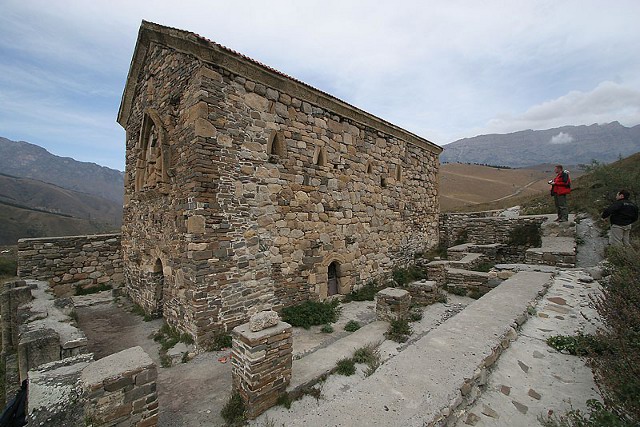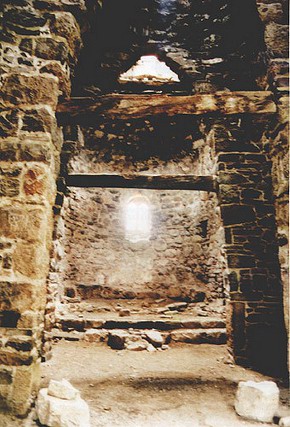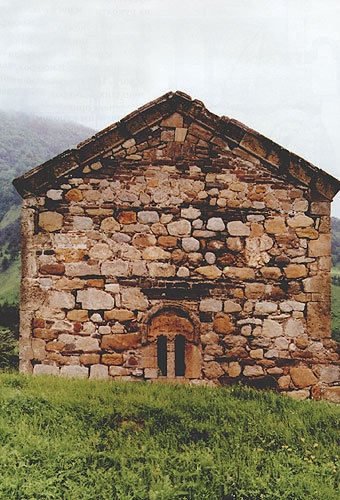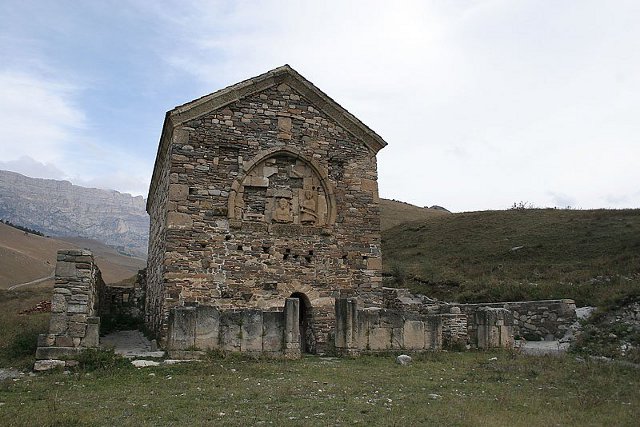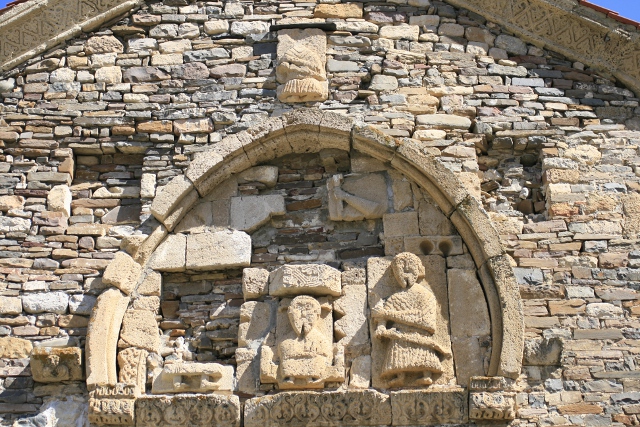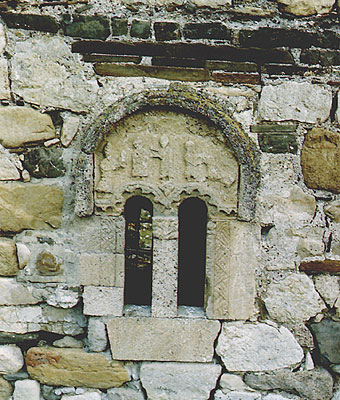Georgian churches in the North Caucasus
Tqaba-erda, Ingushetia
(Photos from Panoramio via Google Earth, text from the Wikipedia article)
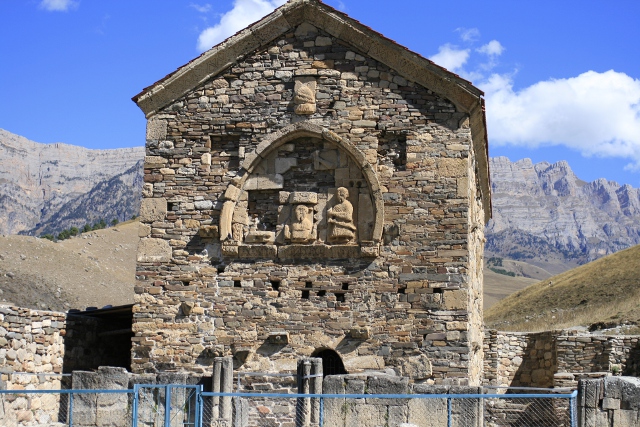
"Tkhaba-Yerdy (Ingush: ТкъобIa–Ерды; Russian: Храм Тхаба–Ерды) is the largest cuboidal shaped temple and is not of Christian origin. It is located in Ingushetia, Russian Federation deep in the Assin Gorge between the auls of Khairakh and Puy, Dzheyrakhsky District, near the border with Georgia. The monument is protected by the State as part of the Dzheirakh-Assin historical and architectural museum and nature reserve.
"The ruins of the Tkhaba-Yerdy Church were first described in 1781 by a Russian army officer Städer known for the accounts of his North Caucasian travels. From the 1880s on, the monument became a subject of study by several Russian, Georgian and Ingush scholars. From 1969 to 1971, a team of Georgian and Ingush specialists led by the architect L. Khimshiashvili and archaeologist G. Ghambashidze carried out a substantial research in the area and reconstructed the church for further conservation. The expedition also offered a novel interpretation of the church’s name. Instead of the hitherto commonly accepted translation as "a church of the Holy Two Thousands", the scholars now suggested that the name might have been derived from the name of St. Thomas.
"According to the evidence the earliest structures of Tkhaba-Yerdy dates back before 8th-9th centuries when it was remodeled. The temple seems to have been completely remodeled during the reign of Queen Tamar of Georgia (r. 1184-1213), and restructured for the last time in the 15th-16th centuries. Originally, the church was a three-nave basilica typical to medieval Georgian architecture, but several elements of the native tradition of mountainous Ingushetia were later introduced by its rebuilders. Although eventual Islamization of the region made the church defunct, it remained a place where the Ingush clansmen gathered to discuss common matters such as raids against enemies, peace-making, and to hold various celebrations.
"The extant edifice is not oriented strictly to the east, but is considerably deviated to the north. The interior is divided by three tall arcades into four unequal sectors. The church retains the fragments of relief sculpture of the façades and ornate details of cornices and arches. A piece of the inscription in Georgian has also survived.
"The Tkhaba-Yerdy Church is one of the four monuments of Ingushetia classified as having a federal importance. The other three are: Albi-Yerdy Church, and the Islamic mausoleums of Borga-Kash and Myatsel.
"The area around the church became a training ground of a unit of the Russian 58th army stationed nearby. In 2001, the president of Ingushetia, Ruslan Aushev, accused the military personnel of profaning the monuments of the Dzheirakh district by "setting up a latrine" near the Tkhaba-Yerdy Church. He also said a military helicopter had destroyed an adjacent burial site. In 2007, concerns about the damage to the historical monuments due to the military exercises in the area was again raised by the director of the Dzheirakh-Assin reserve, M. Kodzoyev, who brought the case to the court, but without achieving any results."
Datuna, Daghestan
(Photos and text from the "Fund of Caucasus" website)
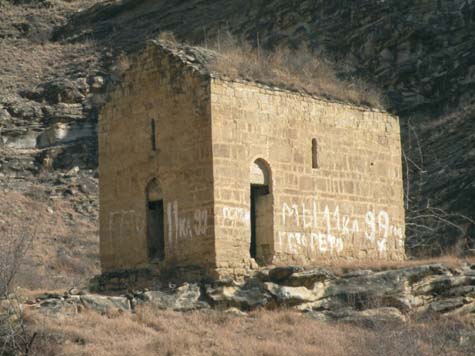
"Since last year [i.e. probably since 2008 — A.B.] Ministry of Culture of Republic of Dagestan is conducting rehabilitation-restoration of a unique monument of medieval Georgian-Dagestan relations – Christian Temple Datuna of the 10th – 11th cc. in Sahmil district.
"We express our great respect towards Minister of Culture of Republic of Dagestan Ms. Z. Suleymanova and her colleagues, specialists-restorers and ktitors financing the project for their appreciative attitude towards the monument of our common cultural heritage.
"From our part, we are ready to provide financial and scientific-advisory support.
"Fund of Caucasus"
"The only Christian church reached up to now is situated in the gorge of the river Avarian Koysu, near v. Datuna. It is a basilica-type church built of cut stone. Well-shaped, strongly extended upwards building stands on the plinth. By its proportions it is close to some monuments of Svaneti and Racha which have much in common with tower architecture of mountainous regions of Georgia (V. Tsintsadze). Semicircular apse is inscribed in rectangular building in the plan. Longitudinal walls separated with ledged pilasters. Common for basilica-churches cambered dome supported by partitioned arcs is decorated with relief cross. The apse has small niches. There are two small chambers on each side of the apse which are lighted from eastern façade through two round apertures. The over-dome premise is lighted through two windows. Each of western and southern walls has one window. The church has three entrances – southern (the main), western and northern. They have tympans. The interior and door tympnas are plastered. We should specially mention that fresco remains are discovered in the tympan of the southern door. The church was covered with flat and channeled tile.
"The church near v. Datuna by its plan conception, methods of partitioning of internal walls by near-wall arcature and some other architectural methods is organically connected with Georgian Christian cult architecture of the end of the 10th – the border of 10th – 11th cc.
"It is noteworthy that the local population who were mainly Muslims from the 14th c., experienced “superstitious awe” towards the above described church even in the end of the 19th c., as well as towards Tkobya-Yerda temple in Ingushetia."
(Givi Gambashidze “Concerning cultural-historical relations of medieval Georgia with peoples of the Northern Caucasus”, Tbilisi, 1977, p. 13.
R, Shmerling, The Church in v. Datuna in Dagestan, “Matsne”, Acad. of Sciences of GSSR, Tbilisi, 1968, No.2, pp. 211-218.)
PROJECT [click to see a PDF copy of the 2009 architectural report on the church (12pp, in Russian) — A.B.]
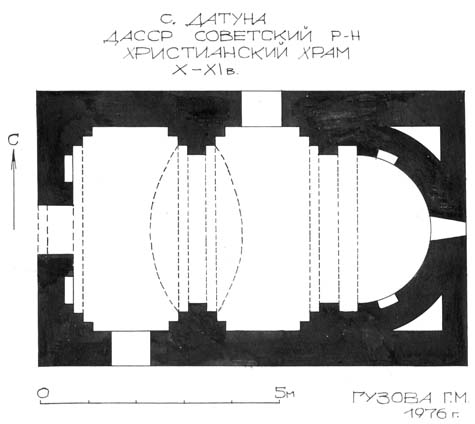
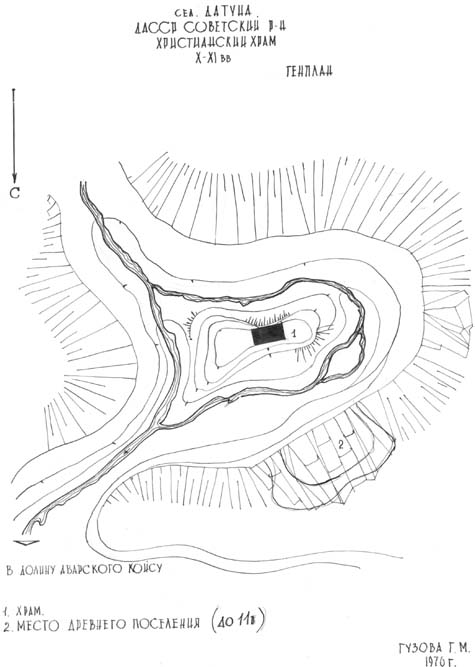
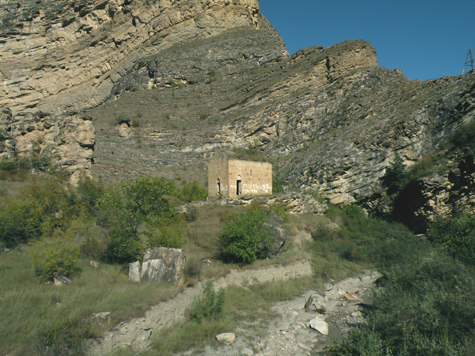
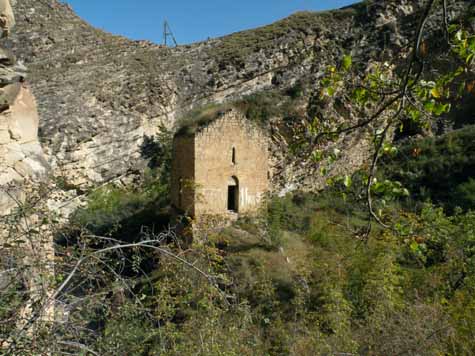
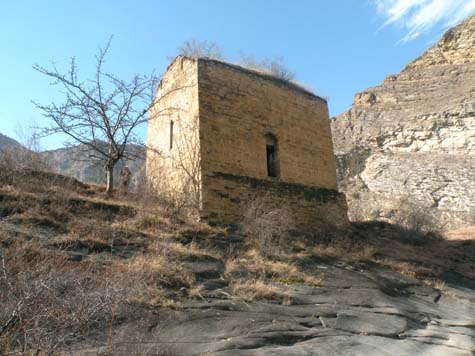
Unless stated otherwise or obviously not the case, all the text and images on this website are © A.J.T. Bainbridge 2006-2011
Do get in touch! Gmail: alexjtb

